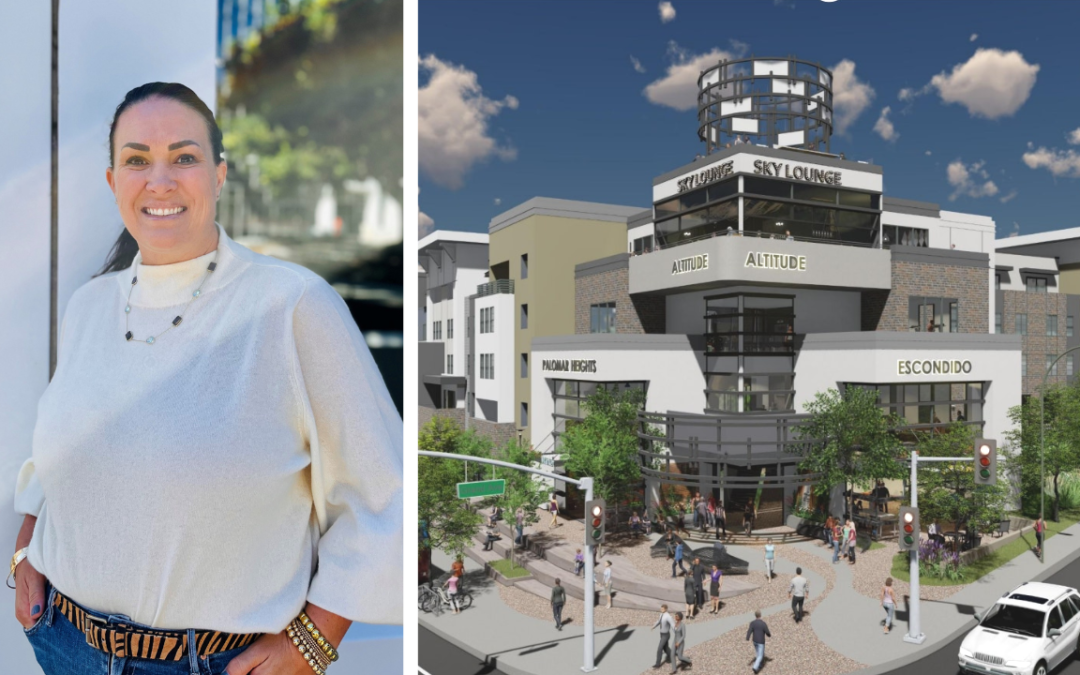The world of community development is changing, and stress levels can be high, but Ninia Hammond is ever-learning and taking it one day at a time. Hammond is a Project Manager for Integral Communities, a forward-planning, land development and entitlement company, based in Carlsbad.
Integral Communities processes complicated re-zones, general plan amendments, and subdivisions with a primary focus on residential. This process can take anywhere from 2-10 years for each project. That’s what they do on paper, but in actuality, Hammond and her team are in the business of embracing, enhancing, and bringing cohesion to existing communities through development.
Integrating Into the Community
“When we come across a particular piece of property, we look at what’s special and unique about it and then try to evaluate what the best overall land use concept would be for it,” said Hammond. “It has to be tailored toward the community.”
To accomplish this, one of Hammond’s favorite things is to go out into the community surrounding the project, find out what does and doesn’t work, and learn what their needs are. She wants to discover what they can do to help the community while they are creating the new development.
For example, Integral Communities has a project in Oceanside next door to the Melba Bishop Park. Since they are to be neighbors, Hammond and her team asked them how they can help. Currently, the park doesn’t have a football field for Oceanside’s nationally recognized teams to practice, and they also have overburdened after-school care needs in the area. Integral Communities is donating $500,000 towards improvements at the City of Oceanside’s discretion to help fund needed improvements at this park.
“Those things, they’re ‘feel good’ for sure, but when I see a problem, I want to know, ‘How can we solve it?’” said Hammond. “We are community members with you. The same things that are important to you are important to me and affect me. How can we do things that can actually be felt by the community? That’s the stuff I love.”
Challenges of Community Development
This kind of community outreach of Hammond’s makes some of the challenging parts of the job just a little easier.
“We do the most complicated and hardest forward-planning entitlement roles… general plan amendments, land use conversions… We try to find properties where the zoning is out of date or doesn’t make sense. We do the tough ones, and we try to add value,” said Hammond.
One of the biggest challenges that Hammond faces in her work, however, is the time it takes for a project to come to completion. Projects can face many delays, even after coming up with a site, conceptualizing a project, and working with the city.
“Then you start to receive public feedback, which is not as organic as it once was. The opposition is more organized. Anything over a certain size is pretty much assured to face a legal challenge,” said Hammond. “All of that has a timeline associated with it. Carrying projects for that long can be challenging and expensive.” And those expenses, unfortunately, increase the rental and purchase prices of the planned units.
However, those same litigations that could be described as a “thorn in a developer’s side” could also have helped transform how developers operate today. “Development as a model has really been changed in the last 20 years. We’ve probably been pushed by some of the community outreach and opposition to do better, to do more,” said Hammond.
Palomar Heights In Escondido
A current Integral Communities projects aims to do just that: enhance the Downtown Escondido community with the Palomar Heights project. The 510-unit project is located on the former 14-acre campus of the Escondido Downtown Palomar Hospital. While others were dissuaded by complicated zoning regulations and required demolition of hazardous materials, Integral Communities took on the project.
“One of the most interesting and hardest things about this project is that it was a hospital. Every single person I talk to about the project in a community outreach aspect has a tie – I was born there; my grandmother passed away there – There is a fondness for it because it was a hospital, but it’s not a place you’d want to live,” said Hammond.
Owing to that fact, Integral Communities committed to changing the energy on the site. They completed the demolition of the old facility and had the site blessed. Now Greystar Property Management, who purchased the main campus, has started grading on the site.
Seamless Cohesion with the Neighborhood
The finished product will integrate into the current building topography in the area. On the corner of Grand Avenue and Valley Parkway, the Westerly-facing “front” of the building, will feature a 90-foot, 10,000-square-foot commercial tower. It will contain a small bodega, sales and leasing office, gym, coworking space, full-service restaurant, and sky bar.
This Westerly side of the project is much more vertical and urban, with four stories of residential units. As it flows toward Fig on the East side, the buildings will taper down to a three-story, row townhome concept that was planned so it would seamlessly flow into the lower, one and two-story buildings on that more residential side of the community.
Supporting Local Businesses
Supporting existing local businesses was also a huge consideration for this project. Some people wanted it to be more like a shopping mall with residential units above. Hammond said that Erik Bruvold, CEO of San Diego North Economic Development Council, was instrumental in providing data about how many businesses already exist in the area and how it would not make sense to implement much more new retail.
“There’s so much retail right there (on Grand Avenue), and it’s local retail, which is what’s so cool. It’s all within walking distance,” said Hammond. Palomar Heights was designed as a beacon at the end of Grand Avenue and Valley Parkway, supporting local businesses by drawing customers down the street toward it.
Keeping with tradition, Palomar Heights also will feature the well-known “Christmas Tree” decoration that topped the old Palomar Hospital during the holiday season.
“Our whole goal is to enhance the community that exists today,” said Hammond. Rather than change everything, Integral Communities fits its projects into the community culture that already exists and makes it part of the project. “We see these sites beyond the cusp of real transformation, and you can see how it might influence things to come.”
Read the story covering Ari Novy, CEO and President of San Diego Botanic Garden here for more content.
Get to know some of North County’s entrepreneurs, innovators, and leaders, and learn why they believe this region is a world-class place to do business. If you would like your company featured in “Meet North County Stewards,” or if you’d like to nominate someone for an interview, click this link to submit your nomination!
About the Author

Caitlyn Canby loves to discover and share people’s stories. She has her bachelor’s degree in Communications, Print Journalism with over 8 years of journalism experience. An Escondido native, she just moved back from Catalina Island to North County with her husband and two children to the town of Fallbrook. Caitlyn enjoys collaborating on projects as Marketing and Events Coordinator at SDNEDC, traveling, and exploring new restaurants, venues, experiences, and cultures.

